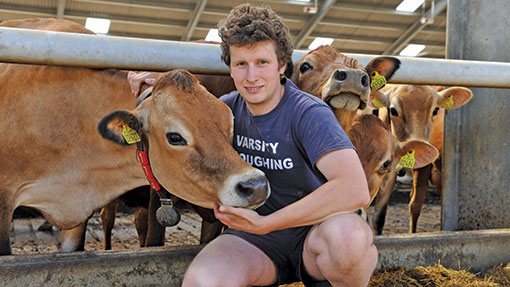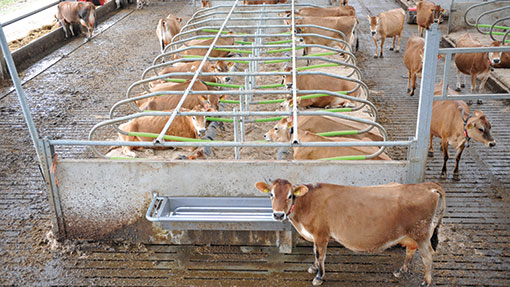Young farmers aims to treble dairy herd in five years

A recent poll found half of all Welsh dairy farmers are planning to expand. Debbie James talks to one young entrant looking at trebling his herd.
Matthew Roberts is a young dairy farmer with a big ambition. In the next five years he aims to expand cow numbers at his family’s north Wales dairy farm from 160 to 500.
He is not alone. In a recent survey, more than half of Wales’ dairy producers confirmed they intended to increase milk production in the next five years.
Matthew is just 25, but his eye is firmly on the future. He says expansion will secure the long-term future of the dairying enterprise.
See also: Jersey dairy cow six years after genetics ban
He graduated from Harper Adams University College with an aspiration to milk cows, but at that time his parents, Richard and Katharine, were renting out Cefn Maesoglan, the family’s 105ha farm at Llangaffo, near Gaerwen.
The Roberts family had previously run the farm as a sheep and arable enterprise, but gave up farming after losing their flock to foot-and-mouth.
Some 10 years later and with a son very keen to establish a milking herd, the Roberts family converted the farm to a dairy unit.
Although Matthew was confident milk production was the right way forward for the business, the prospect of milking cows twice a day was less appealing. By starting with a blank canvas, he was able to shape the system to suit the family’s needs and those of the market.
The solution was a fully-housed operation with 160 pedigree Jerseys milked by two robots. Each robot is capable of processing 2,000 litres/day. The machines are operational around the clock, but there is a recommended downtime of 12-15% for washing and maintenance.
The year-round calving pattern also suited the most lucrative milk contracts available when the business was established. At that time, milk buyers were not interested in spring milk, so the alternatives were an autumn block or a 365-day calving pattern.
The system has been in place for just 18 months but expansion is already under way. A new shed is being built to allow cow numbers to increase to 500 in the next five years. A further two robots will be installed for the first phase of expansion – to increase the herd to 300 in the next 12 months.
Matthew says expansion means the fixed costs incurred during the initial development phase can be spread across a greater number of cows.
“We have made a substantial investment in milk production, so expanding cow numbers will spread that cost across the business,” he says.
“Even though we will double the herd size, the costs won’t double because we have much of the infrastructure already in place. We have done the big spend, so by getting more cows, we will be able to reduce those costs a cow.’’
The priority is to increase numbers through the farm’s own replacements and by buying further Jersey heifers from Denmark.
But Matthew is also keeping a close eye on enhancing herd performance. Only the top 50% of the herd is served to dairy bulls – beef bulls are used on the bottom half. “We are trying to keep the best cows coming into the herd,” Matthew explains.

He has planned for a 25% replacement rate to keep the herd young, but believes the cows could achieve an eight-lactation average if needed.
Calving index in the first 60 calvers this year averaged 335 days, so Matthew will delay first service in an attempt to achieve a 365-day average. Some 74% of the herd was in-calf at first service and 94% at second service.
“Starting the herd with heifers has probably helped that,” Matthew suggests. The Jerseys were sourced from Denmark as point-of-calving heifers.
The breed is fertile and easy to handle, but with strong American genetics in the bloodline, the herd is achieving good yields and high milk solids.
Cows are yielding an average of 23kg – 6,400 litres annually – at 6% butterfat and 4% protein. The milk is perfectly matched to the farm’s cheese contract with Glanbia, supplying the nearby Llangefni factory.
The aim is to have a closed herd with a “robot-ready” cow with a well-positioned udder, fast milk drop and good feet – an essential characteristic in a housed system. Genomics will be used to shorten the breeding programme.
A benefit of robotic milking is that every quarter is properly milked and this is reflected in udder health, with a somatic cell count of 62,000 cells/100ml and a bactoscan of 8. “We are able to monitor cell counts through the robots,” says Matthew.
There have only been six cases of mastitis since the herd was established and those incidents were in fresh calvers.
Such has been the success of the robots that Matthew would never consider changing to a manual system. Feeding the cows and youngstock and changing the filters on the robots takes about an hour- and-a-half in the morning and less than an hour in the afternoon.
A manual system would also require additional labour and this isn’t a route the Robertses would choose. “I know a dairy farmer who employs seven staff and every one of them milks in a different way. He can tell which employee has been milking just by looking at the production graph,” says Richard.
The expansion plan has been aided by the strong milk price – in February the high-constituents milk earned 46p/litre. The milk price is now heading downwards, but with the business plan budget based on 34p/litre, this won’t be an impediment to growth.
The strong milk price has underpinned the new business and the Robertses are ahead of where they expected to be at this point.
Funding the infrastructure needed to establish the dairy unit required a good business plan. The banks would lend against the equity the Roberts family had in the land, but they had no track record of dairy farming.
A good plan convinced a bank to give them the funding they needed to establish the business.
Having a succession plan is very much on the minds of both generations as the business grows and moves forward.
A framework has not yet been put in place but it will happen. “It is definitely something we are thinking about,” says Matthew.
“We haven’t finalised anything as yet, but when we have a bit more time after the current building work is completed, it is something we intend to look at.”
His parents share this sentiment. “If you are under 50 and have the courage to go out and invest, there is a really good future in milk,” says Richard.
Farm facts Cefn Maesoglan, Gaerwen, Anglesey
- Fully housed, year-round calving
- 60 pedigree Jerseys milked with two robots
- Averaging 6,400 litres/year at 6% butterfat and 4% protein
- Supplying Glanbia on a cheese contract
Talent watch
Farming needs fresh talent such as Matthew Roberts – innovative people who harness technology to meet the challenges of producing more food with less effect on the environment. The Farmers Apprentice contest highlights how fabulous and dynamic farming is with a series of episodes released this autumn. You can watch them at www.farmersapprentice.co.uk.
